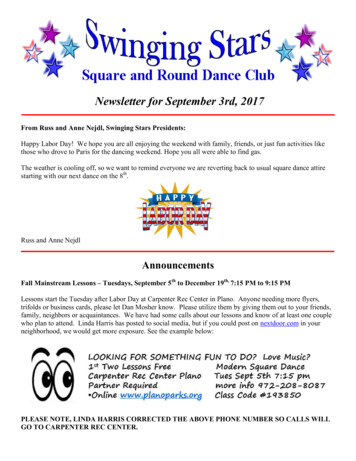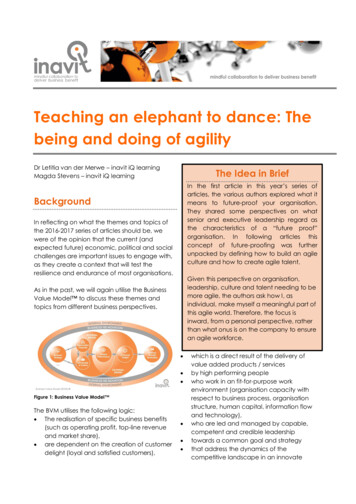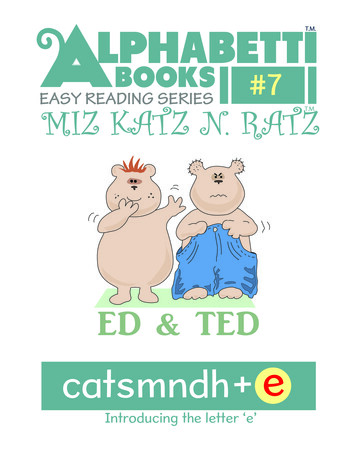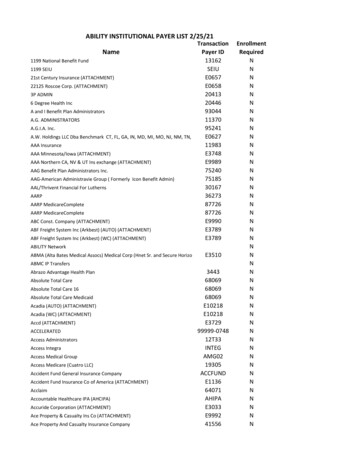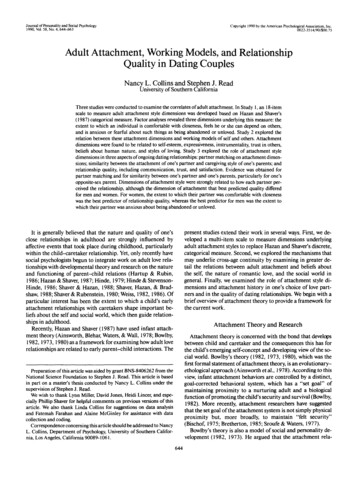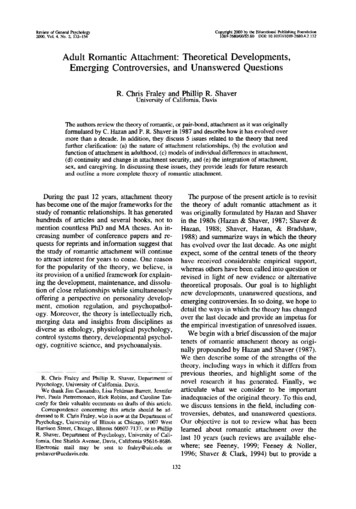
Transcription
6/28/19The Dance of Attachment:The Therapist’s Use of Self and Self-Care inthe Treatment of Developmental TraumaDeany Laliotis, LICSWDirector of Training, Senior Trainer, EMDR InstituteCo-Director EMDR of Greater WashingtonWashington, DC USAwww.deanylaliotis.comJune 29, 2019EMDR Europe Conference Krakow, Poland 2019 Deany Laliotis, LICSWOne of the greatest gifts is to bethe midwife of the soul inanother person.Plato 2019 Deany Laliotis, LICSWIntroduction EMDR therapy is an experientially-based approach It is about experience unfolding in a moment-to-moment way It’s not just about what happened; it’s also about whathappened next and what’s happening now In addition to reprocessing memory as the primary focus, weare also part of the client’s experience Parallel process is memory in the making 2019 Deany Laliotis, LICSW1
6/28/19Make what is implicit, explicitMake what is explicit, experientialMake the experience relationalMake it all transformativeDiana Fosha 2019 Deany Laliotis, LICSWIntroduction The therapeutic relationship is co-created by therapist andclient Creates the context for psychotherapy The therapeutic dyad as the primary vehicle for change EMDR psychotherapy within the relational context is aboutgenerating corrective as well as reparative experiences of selfin relation to the other 2019 Deany Laliotis, LICSWIntroduction The corrective experience of the therapeutic relationship thathas a secure base allows the client to:– Deconstruct the attachment patterns of the past;– Construct new, adaptive patterns of attachment in thepresent;– Transform their sense of self, relationships in their future 2019 Deany Laliotis, LICSW2
6/28/19Introduction As [EMDR] therapists, our exposure to trauma is much higherthan for therapists who have a general practice or specialize inother modalities (Figley, 2012) Being in relationship with many clients who are severelytraumatized puts us at risk for stress-related responses of ourown 2019 Deany Laliotis, LICSWIntroduction Our greatest asset, that is, our ability to be present to theclient’s experience, to empathize and attune, is also ourbiggest vulnerability Therapists who are challenged by a personal crisis or achallenging work environment are also more likely to developsymptoms 2019 Deany Laliotis, LICSWIntroduction Therapists who have an unresolved trauma history are morevulnerable to stress-related conditions (Figley, 2012) Our own formative attachment experiences and our patternsof response are also a variable (Wallin, 2009) 2019 Deany Laliotis, LICSW3
6/28/19Secondary Stress Injuries for Therapists Compassion Fatigue Secondary Traumatic Stress Vicarious Trauma Burnout Shared TraumaBasics of Compassion Fatigue by Charles Figley, 2012 2019 Deany Laliotis, LICSWCompassion Fatigue Emotional and physical exhaustion that affects us over timeDecrease in emotional responsivenessDecrease in quality of careMore clinical errorsIncrease in anxiety and depressionGreater difficulty empathizing 2019 Deany Laliotis, LICSWSecondary Traumatic Stress Where we, as therapists, are secondarily traumatized byhearing about the trauma Effects are the same as if you had the primary exposureyourself 2019 Deany Laliotis, LICSW4
6/28/19Vicarious Trauma When we, as therapists over-identify with the client’s trauma Results from an empathic engagement with one or moretraumatized clients Results in loss of meaning, sense of hopelessness,powerlessness 2019 Deany Laliotis, LICSWBurnout Prolonged exposure to high levels of stress Too many clients, too heavy a workload, too many competingdemands, challenging work environment 2019 Deany Laliotis, LICSWShared Trauma When the same event happens to all of us Can have different responses to the same event More dialogue about the shared experience 2019 Deany Laliotis, LICSW5
6/28/19Attachment Theory Internal working models of attachment, operating at nonconscious levels have encoded strategies of affect state andarousal regulation; storing critical information about the mindand body of self and other (Schore, 2004) This includes us as well as our clients Brings into play the interplay between our relational historiesas well as the client’s 2019 Deany Laliotis, LICSWAttachment Theory Attachment as regulation (Pipp & Harmon, 1987):Homeostatic regulation between members of a dyad is a stableaspect of all intimate relationships throughout the lifespan Both therapist and client are being influenced by implicitmemory that is being evoked through nonverbal as well asverbal communications 2019 Deany Laliotis, LICSWAttachment Theory The co-constructed relationship between therapist and client isboth internal and interpersonal The experience and behavior of both therapist and client willunavoidably be shaped unconsciously both by who we are aspeople independent of the relationship as well as who we arein response to that relationship 2019 Deany Laliotis, LICSW6
6/28/19Therapist Attachment Styles The “all good” objective therapist who is a blank slate is a myth The client who has “everything they need” in order to movetowards health is also a myth Relationship between therapist and client creates the contextwhere change is possible 2019 Deany Laliotis, LICSWTherapist Attachment Styles As therapists, our ability to generate a secure attachmentexperience with our clients largely depends on our ownattachment history Stance of the self predicts attachment security better than thefacts of the personal history (Wallin, 2009) 2019 Deany Laliotis, LICSWTherapist Attachment Styles Most of us, even if we have a predominantly secureattachment have “islands” of trauma and dissociation in ourhistory (Bromberg, 1998a) Working with early developmental trauma can activate ourown memory networks that can inform how we respond to ourclients 2019 Deany Laliotis, LICSW7
6/28/19Therapist Attachment Styles It is not necessarily that our formative attachment experiencesare painful per se, it is the lack of resolution Consistent with EMDR AIP theory that our perceptions as wellas our conclusions about ourselves, others and relationshipsorganize our experience of self in the present 2019 Deany Laliotis, LICSWTherapist Attachment Styles How did we self-select into becoming professional “helpers?” Our own formative attachment experiences set the templatefor becoming a therapist Intergenerational transmission of trauma Developed controlling-caregiving strategies (Wallin, 2009) These adaptations/strategies are both our strengths and ourvulnerabilities 2019 Deany Laliotis, LICSWTherapists Attachment Styles Attachment patterns are known but not necessarilyremembered What we think, how we feel, what is “real” for us versus whatis true in the present To the extent that we know ourselves determines to whatextent we can know the other Therapeutic impasses often related to the interplay betweenthe client’s and the therapist’s attachment patterns 2019 Deany Laliotis, LICSW8
6/28/19EMDR Therapy Case Conceptualization– Client is engaged in reenactments of familial relationshipswith significant others in the present– Have significant developmental deficits– Unmet dependency needs from childhood that can manifestas extreme dependency and counter-dependency 2019 Deany Laliotis, LICSWEMDR Therapy Case Conceptualization– Developed adaptations in childhood that helped them survivetheir situation– Adaptations are now overdeveloped, habituated and oftenproblematic– Need to identify and process formative attachmentexperiences where the client learned to apply theseadaptations 2019 Deany Laliotis, LICSWIt’s not just about what happened;it’s also about what happened next.DL 2019 Deany Laliotis, LICSW9
6/28/19Maladaptive Coping Styles in Response toDevelopmental Trauma SURRENDER(freeze, collapse,submit, passivity,victim stance)InhibitoryPatterns ofResponseAVOIDANCE(flight, escape, evasion)ExcitatoryPatterns ofResponse(Adapted from Young, Klosko, & Weishaar, 2003;Korn & Laliotis, 2012, Laliotis, 2014) 2019 Deany Laliotis, LICSWOVERCOMPENSATION(reaction functioning)PROJECTION/EXTERNALIZATION(fight, victimizer; protector;other-focused)Adult Attachment Styles Secure AttachmentAnxious-Preoccupied AttachmentAvoidant-Dismissive AttachmentDisorganized AttachmentEarned, Secure Attachment(Siegel, 2001, 2007; Fosha, 2000) Predominant attachment style Attachment as a state of mind 2019 Deany Laliotis, LICSWSecure Attachment Affective CompetenceFeeling and dealing while relatingAble to feel and process emotions in dyadFlexible strategies in relational experiences of affectCapable of intimacy and reflective self-functioning; ability torepair 2019 Deany Laliotis, LICSW10
6/28/19Secure Attachment Often results in rich, intimate exchanges Able to maintain integrity of self and other Able to tolerate separation and reunion w/o beingoverwhelmed Capable of self and interpersonal regulation Has clear emotional boundaries and assumes responsibility fortheir own well-being in the context of relationships 2019 Deany Laliotis, LICSWSecure Attachment State of Mind Client strengths– Acknowledges and has empathy for his/her owndependency needs and wishes– Higher integrative capacity– Accepts limitations of therapy and the therapist– Willing to grieve their early attachment losses 2019 Deany Laliotis, LICSWSecure Attachment State of Mind– Has capacity for co-consciousness and willing to take on therole of primary caretaker of the Self– Has empathy for the younger parts of self that are bothdependent and counter-dependent– Can manage their unmet dependency needs and behaviorswithin their window of tolerance most of the time 2019 Deany Laliotis, LICSW11
6/28/19Secure Attachment State of Mind– Understands and allows for dependency on the therapistwhile working on improving functioning in daily life– Able to approach intimacy in relationships– Greater capacity to manage emotional systems anddefensive systems 2019 Deany Laliotis, LICSWSecure Attachment State of Mind Therapist’s strengths:– Noticing, observing– Present to the client– Grounded in our own experience– Can use our felt sense of the client to track their experiencewithout merging– Sense of safety and trust in the process, even when it’s unclearhow to proceed 2019 Deany Laliotis, LICSWSecure Attachment State of Mind– Detached compassion– Responsive versus reactive– Questioning, challenging– Relational, authentic in our emotional response– Have flexible strategies in response to what is neededclinically– Seek support and case consultation 2019 Deany Laliotis, LICSW12
6/28/19Anxious – Preoccupied Attachment Feeling but not dealing; easily hyperaroused under stress Insecure, resistant; Core experience is uncertainty Can’t let go at separation, difficulty being soothed uponreunion; Unable to resume independent or exploratory functioning 2019 Deany Laliotis, LICSWAnxious – Preoccupied Attachment Too much anxiety mixed in with affect due to caregiver’sunreliability (less affective competence) High emotionality (vs. access to core affective experiences)that interfere w/ functioning; child parts (exiles) Confusion about the integrity of relationships in the present 2019 Deany Laliotis, LICSWAnxious – Preoccupied AttachmentEMDR challenge is to: Bring awareness to the underlying uncertainty Tolerate the anxiety/fear/shame within the context of thedyad/ present moment Observe the anxiety vs. being in it 2019 Deany Laliotis, LICSW13
6/28/19Anxious – Preoccupied Attachment Utilize the therapeutic dyad to tolerate negative affects aboutthe self that resulted from these formative experiences Differentiate past versus present Explore client choices now and in the future 2019 Deany Laliotis, LICSWAnxious-Preoccupied Attachment Client strengths:– Is more relational– Greater access to emotions– Is generally unafraid of difficult affects– Responsive to co-regulation of affect with the therapist– Can approach their internal experience and can make senseof it– Can track self and other with guidance 2019 Deany Laliotis, LICSWAnxious-Preoccupied Attachment Client vulnerabilities:– Greater emotional instability in and out of sessions– Affect dysregulation– Lower integrative capacity– Confused about how they really feel or what they reallyneed– Other-focused; co-dependent, caretaking– Emotional boundaries blurred (enmeshed) 2019 Deany Laliotis, LICSW14
6/28/19Anxious-Preoccupied Attachment– Confused about integrity of self; more often defined byperceived expectations of others– Can have sense of entitlement to be taken care of ( may ormay not be in awareness)– Can express extreme dependency needs by overreliance onthe therapist– Struggles to accept limitations of the therapy and therapist– It’s all about attachment 2019 Deany Laliotis, LICSWAnxious-Preoccupied State of Mind Therapist strengths:– Focused on the client– Greater access to feelings– Highly intuitive– Greater capacity for warmth and empathic connection– Can easily track somatically the client’s experience– Can use information in the resonance to track subtleties inthe client’s experience 2019 Deany Laliotis, LICSWAnxious-Preoccupied State of Mind Therapist vulnerabilities:– Tendency to merge; to over-identify; difficulty offeringalternative perspectives– Too much emphasis on feelings; not enough accountability;trouble with boundaries and difficulty setting limits– Tendency towards over-activity in our role as a therapistdriven by anxiety and the need to fix it– May intervene or treat without permission 2019 Deany Laliotis, LICSW15
6/28/19Anxious-Preoccupied State of Mind– Tendency to over-focus on the client’s experience nottracking their own– Can submit to the client’s need to be taken care of– Can become over-active in their interpretations orinterventions– Shame and self-blame when it’s not working well– Preoccupied with our own effectiveness 2019 Deany Laliotis, LICSWDismissive-Avoidant Attachment Dealing but not feeling Sacrifices his/her internal life in order to function Uninterrupted self-engagement; hypo-aroused under stress Shows neither distress at separation nor joy at reunion 2019 Deany Laliotis, LICSWDismissive-Avoidant Attachment Relationship is maintained through minimizing its importance& suppressing emotional experience (“as if” indifferent); welldeveloped “manager” parts Minimal relational engagement (doesn’t feel, therefore doesn’tengage); good at self-regulation versus interpersonalregulation 2019 Deany Laliotis, LICSW16
6/28/19Dismissive- Avoidant AttachmentEMDR challenge is to: Access memories; often experiences of neglect or absence ofcare or attunement Access their experience of emotion and soma (“felt sense”) Access their sense of relationship with self/other in themoment 2019 Deany Laliotis, LICSWDismissive-Avoidant Attachment Challenge their minimizing of relationships as important;counter-dependency stance Differentiate past relationships from present Generate reparative experiences where the client is “allowed”to feel his feelings and express them to the “other” 2019 Deany Laliotis, LICSWDismissive-Avoidant Attachment Client strengths:– Is more task-focused and behaviorally oriented– Tends to be compliant with homework and other clinicalinterventions 2019 Deany Laliotis, LICSW17
6/28/19Dismissive-Avoidant Attachment– Highly self-regulated; wants to be in charge– More cognitive; greater need to know and understand– Greater capacity to develop coping strategies to managechallenge situations– Respond to what is expected of them 2019 Deany Laliotis, LICSWDismissive-Avoidant Attachment Client vulnerabilities:– Limited access to emotions; can be affect phobic or overregulated– Difficulty with interpersonal regulation of affect 2019 Deany Laliotis, LICSWDismissive-Avoidant Attachment– Limited memory recall due to denial or minimization ofexperience– Minimizes importance of attachment bond; can bedismissive– Denies dependency needs and wishes 2019 Deany Laliotis, LICSW18
6/28/19Dismissive-Avoidant Attachment– Shame and disgust towards self and others whoacknowledge dependency needs– Pseudo-autonomous– Unable to allow for dependency needs to be met in therapyor by therapist (any attachment triggers dependency needs)– Engage in behaviors that are usually attachment-related butw/o attachment (e.g., sex addiction) 2019 Deany Laliotis, LICSWAvoidant-Dismissive State of Mind Therapist’s strengths:– Ability to focus; particularly on the task at hand– Good at offering suggestions, advice;– Cognitive; strategic– Analytic– Ability to set boundaries and limits 2019 Deany Laliotis, LICSWAvoidant-Dismissive State of Mind Therapist’s vulnerabilities:– Over-focused on the task at the expense of the relationship– Difficulty tracking the client’s experience, especially withcompliance– Tendency to analyze experience or give direction, ratherthan to explore or deepen the client’s experience 2019 Deany Laliotis, LICSW19
6/28/19Avoidant-Dismissive State of Mind– Focus on thinking rather than feeling– Focus on behavior (i.e., to externalize) rather than oninternal states– Can move towards emotional withdrawal rather thanintimacy– Can over-function as a reaction to uncertainty– Can respond to the client’s minimizing stance by being angryand dismissive 2019 Deany Laliotis, LICSWInsecure-Disorganized Attachment Not feeling and not dealing Psychic equivalent of the body going into shock Momentary emotional loss produces intense anxiety andoverwhelming affect; oscillates between hyper andhypoarousal Attachment bond itself is threatened Experiences simultaneously the impulse to move toward aswell as move away from the caregiver 2019 Deany Laliotis, LICSWInsecure-Disorganized Attachment Often experiences caregiver as alternately frightening andfrightened; lack of holding environment Primary affect is fear which leads to splitting and dissociationin order to cope Tremendous difficulty in self and interpersonal regulation 2019 Deany Laliotis, LICSW20
6/28/19Insecure-Disorganized AttachmentEMDR challenge is to: Access dissociative states without prefrontal cortex shutdown Manage the processing demands so as not to overshoot thetherapeutic window of tolerance Manage defenses that will invariably arise to protect the client 2019 Deany Laliotis, LICSWInsecure-Disorganized Attachment Balance the need for dyadic support for emotional regulationvs. inadvertently meeting unmet dependency needs Address transference reactions to the therapist when the clientbecomes frightened or confused about the integrity of therelationship 2019 Deany Laliotis, LICSWInsecure-Disorganized State of Mind Client strengths:– Well-developed survival strategies– Come into therapy with an appreciation of theirdevelopmental trauma history– Can respond well to therapeutic interventions when offeredincrementally– Can be extremely attuned to the therapist’s state of mind 2019 Deany Laliotis, LICSW21
6/28/19Insecure-Disorganized State of Mind Client vulnerabilities:– Can easily oscillate between states of dependency andcounter-dependency– Survival strategies of fight, flight, freeze and submission canbe easily triggered in a therapeutic context– Can become frightened or confused about the integrity ofthe relationship with the therapist– Lower integrative capacity 2019 Deany Laliotis, LICSWInsecure-Disorganized State of Mind–Can easily dissociate and become disoriented; hasdifficulty with co-consciousness–Difficulty assuming role of primary caretaker due tooscillation between hyper and hypoactive states andseverity of abuse and neglect of needs 2019 Deany Laliotis, LICSWInsecure-Disorganized State of Mind–Has difficulty not acting out of these extreme states;pervasive difficulty with dual awareness–Has difficulty with safety and trust–Difficulty asking for appropriate help 2019 Deany Laliotis, LICSW22
6/28/19Insecure-Disorganized State of Mind Therapist strengths:– Greater sensitivity to the experience of trauma– Understands it through their own experience/identificationwith it– Great capacity for empathy– Understands Victim/Victimizer/Rescuer dynamics 2019 Deany Laliotis, LICSWInsecure-Disorganized State of Mind Therapist vulnerabilities:– Can be over-focused on the traumatic history and get into itprematurely, OR– Avoid addressing trauma history altogether for fear of itbecoming overwhelming to the client– Can oscillate in and out of positions of Victim, Victimizer orRescuer due to collision or collusion between the client’shistory and our own 2019 Deany Laliotis, LICSWInsecure-Disorganized Attachment– Countertransference reactions we can have to the client’sdisorganized state:ØFeeling lost and overwhelmedØChecking out or dissociatingØFeeling incompetentØFeeling anxious that you will be rejected by the clientØFearful the client will hurt themselves 2019 Deany Laliotis, LICSW23
6/28/19Earned-Secure Attachment Develop a new, more adaptive pattern of attachment andrelatedness Feel secure about ourselves/themselves/others Develop an integrated narrative about themselves and thecaregiver(s) that includes a recognition of the impact of pasthistory 2019 Deany Laliotis, LICSWEarned-Secure Attachment Ability to self-regulate; greater access to authentic experiences(core affects) and insights Ability to deal and feel within the context of relatedness;attuned communication Greater resiliency to navigate emotional needs andcommunicate them effectively within the context of being inrelationship 2019 Deany Laliotis, LICSWOur capacity for compassion is limited only bythe compassion we have for ourselves.DL 2019 Deany Laliotis, LICSW24
6/28/19THE MINDFUL THERAPIST:WHAT SKILLS ARE NEEDED? 2019 Deany Laliotis, LICSWTherapist Mindfulness Skills Ability to be present: tracking sensory aspects of our own and theclient’s experience in the moment Ability to be non-reactive: the rate and ability to achieveequanimity under stress 2019 Deany Laliotis, LICSWTherapist Mindfulness Skills Ability to be humble: cross-check impressions and applyingdiscernment in one’s judgment Ability to label and describe: To put into words one’s internalexperience (Siegel, 2009) 2019 Deany Laliotis, LICSW25
6/28/19Therapist Mindfulness Skills Capacity to self-observe: the ability to observe one’s ownresponses Check our intentions: whose needs are being met? Capacity for interoception: To ask oneself, “What is going oninside of me?” 2019 Deany Laliotis, LICSWTherapist Mindfulness Skills Capacity to remain curious: what is happening or what is neededin the moment; mental flexibility Tolerate not knowing: space for greater clarity Practice attunement: engaged and detached with compassion 2019 Deany Laliotis, LICSWTherapist Mindfulness Skills Being mindful that there is a parallel process that you’re cocreating memory together As you’re having an effect on them, the client is having an effect onyou and your responses The intersubjective field co-constructed by two individuals includesnot just two minds, but two bodies. (Schore, 1994, 2003a,b). 2019 Deany Laliotis, LICSW26
6/28/19Therapist Mindfulness Skills The experience of being felt by another giving the person a senseof stability and safety in the present moment Creates a neural state of integration How does it feel to the client to be known by you? 2019 Deany Laliotis, LICSWTherapist Mindfulness Skills How do you know the difference between “holding inawareness” versus “helping”? “Being” state versus “doing” state Feeling “felt” or “perceived” by the other –“neuroception” ofsafety (Porges, 1998) 2019 Deany Laliotis, LICSWTherapist Mindfulness Skills From interoception (inside our own minds) to neuroception The coordination of input from another mind with the activity ofone’s own mind Being aware of the present moment tracking simultaneously innerand outer experience w/o judging and evaluating (oneness versusmerging) 2019 Deany Laliotis, LICSW27
6/28/19NEXT STEPS: 2019 Deany Laliotis, LICSWMake an executive decision to adoptself-care strategies!WHY? 2019 Deany Laliotis, LICSWStandards of Self- Care (Figley, 2012) First, do no harm to oneself Take care of physical, social, emotional and spiritual needs Ensures the highest quality of care to others when we care atthe same level for ourselves We model self-care, self-esteem, self-compassion Our ethical responsibility to keep our instrument finely tuned 2019 Deany Laliotis, LICSW28
6/28/19Daily Mindfulness Practice (Laliotis & Merlis, 2015)2-3 times a day: Close your eyes and feel into your body Assess level of activation (0-10) Ask, is your level of activation appropriate to the task orsituation? If yes, ok. If level of activation is out of proportion, give a self-commandto apply a state-shift strategy of your choosing 2019 Deany Laliotis, LICSWWheel of Awareness Meditation(AWARE, Dan Siegel, 2019, in press)Six things to do for ongoing therapist self-care:Be in an ongoing case consultation group10-20 minutes of meditation every morningMake transition time between practice and homeBe present to one’s experience in the moment; check in!Maintain physical and emotional health to include restorativepractices Slow down your “YES” responses and say “NO” more often! 2019 Deany Laliotis, LICSW29
6/28/19About Deany Laliotis Senior Trainer, Director of Training, EMDR Institute Co-Director of EMDR of Greater Washington, DC Web-based ongoing case consultation and in-depth interactive casestudies Specializes in the application of EMDR Therapy to developmentaltrauma and attachment disorders Private Practice, Washington, DC USA 2019 Deany Laliotis, LICSWFor More Information Email me at: info@deanylaliotis.com Add your name to my mailing list at: www.deanylaliotis.com References available upon request 2019 Deany Laliotis, LICSW“And the day came when therisk it took to remain tight inthe bud was more painfulthan the risk it took toblossom.”Anais Nin 2019 Deany Laliotis, LICSW30
The Dance of Attachment: The Therapist’s Use of Self and Self-Care in the Treatment of Developmental Trauma Deany Laliotis, LICSW Director of Training, Senior Trainer, EMDR Institute Co-Director EMDR of Greater Washington Washington, DC USA www.deanylaliotis.com June 29, 2019 EMDR Eur


